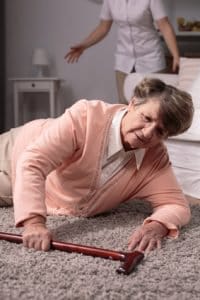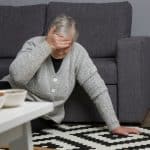As we get older, daily tasks that were once done without any thought can become troublesome and even dangerous. The risk of tripping or taking a fall increases with age and decline related to health issues. As mobility decreases, dangers in the home environment seem to rise, and fall prevention tips become necessary. Having a medical alert device can give you peace of mind that emergency help can come fast. Read our Lifeline reviews for all the details on automatic fall detection.
What can a caregiver do to help his or her elder loved one’s age in place? There are many home modifications and senior care options available that range from in-home caregiving, asking friends, family or neighbors for help or taking on the role of full-time caregiver for your loved one. There are other ways, though that you can help and that comes in the form of elder-proofing the home as a way to make it safer for them.
Medical Alert Advices outlines some senior proof options that may help in preventing falls and promote aging-in-place for a longer period of time.
Senior Proofing Tips to Prevent Falls
- Upgrade and update the bathroom to make it more senior-friendly. Add non-slip shower mats because many in-home accidents occur in the bathroom due to slippery surfaces.
- Add safety grab bars next to the toilet and shower to provide extra stability and increase safety.
- Make certain there is a non-slip bath mat next to the bathtub or shower as well as in the shower to reduce the risk of falls. A slippery tub or shower floor is very dangerous especially as we age.
- A shower chair will also help assure stability when bathing and showering and can make it much easier for those who find bending to be problematic.
- Glass shower doors can be troublesome for some elderly persons. Add stickers or decals to the glass so they can distinctively see it.
- Check the hot waster setting in the home, you may want to reduce the max temperature by a few degrees to avoid scalding burns. The recommended setting is 120 degrees Fahrenheit or below. Also, be sure that the hot and cold water gauges are clearly marked on all faucets.
- Give the house a walk-through and make certain there are no trip or fall hazards. Check for obstacles in the hallways to and from the rooms in the house. Clear clutter, look for rugs, extension or other cords, stacks of magazines or books and other items that we take for granted but could become a hazard. Adding a non-slip mat to the bottom of all rugs can help reduce tripping hazards.
- Cover corners and sharp edges, such as coffee tables, with specially designed padding to avoid bumps or cuts on edges.
- Move objects in kitchen cabinets to lower shelves so no one has to reach or climb to get them. For many older adults, bending to get things from low shelves or reaching for top shelves just isn’t an option any longer.
- Invest in an “extended grabber”. These tools help anyone reach objects on high shelves, items that have fallen behind furniture or even an item dropped at their feet.
- Make sure the home has a fire extinguisher as well as smoke and carbon monoxide detectors. Regularly check the system’s batteries.
- Purchase a medical alert system. These devices can be literal lifesavers. In the event of a medical emergency or a trip or fall accident, your loved one will only have to push a button to gain access to emergency care in seconds. Even in the middle of the night, your loved one will be protected. Some medical alert devices even have automatic fall detection that will alert the monitoring center when a fall is detected.
- Install lighting that is motion activated. This helps not only brighten a path to and from rooms but assures the lights will turn off by themselves. Motion sensor lights at the front door can also potentially help keep your family safe from intruders.
- If your loved ones are tech savvy, invest in a computer and stay in touch with them through video applications or video telephone calls (Skype and FaceTime are common applications) – this is especially helpful if you live far away.
- If stairs are a problem for your loved one, you might want to consider adding ramps or even a stair lift to make it easier for them. Make sure all railings are safely secured.
Your loved one may not like the fact that you’re safety proofing their home so be gentle and considerate with the suggestions and improvements you make. Spend time with your loved one to uncover their plans as they age and work with them to help make it a reality. Remember, by senior proofing your home, you may be able to avoid assisted living facilities or nursing homes for much longer.
Want more tips and ideas? See this article: Tips on Making a Home Safe and Accessible for Seniors for more great ideas.



